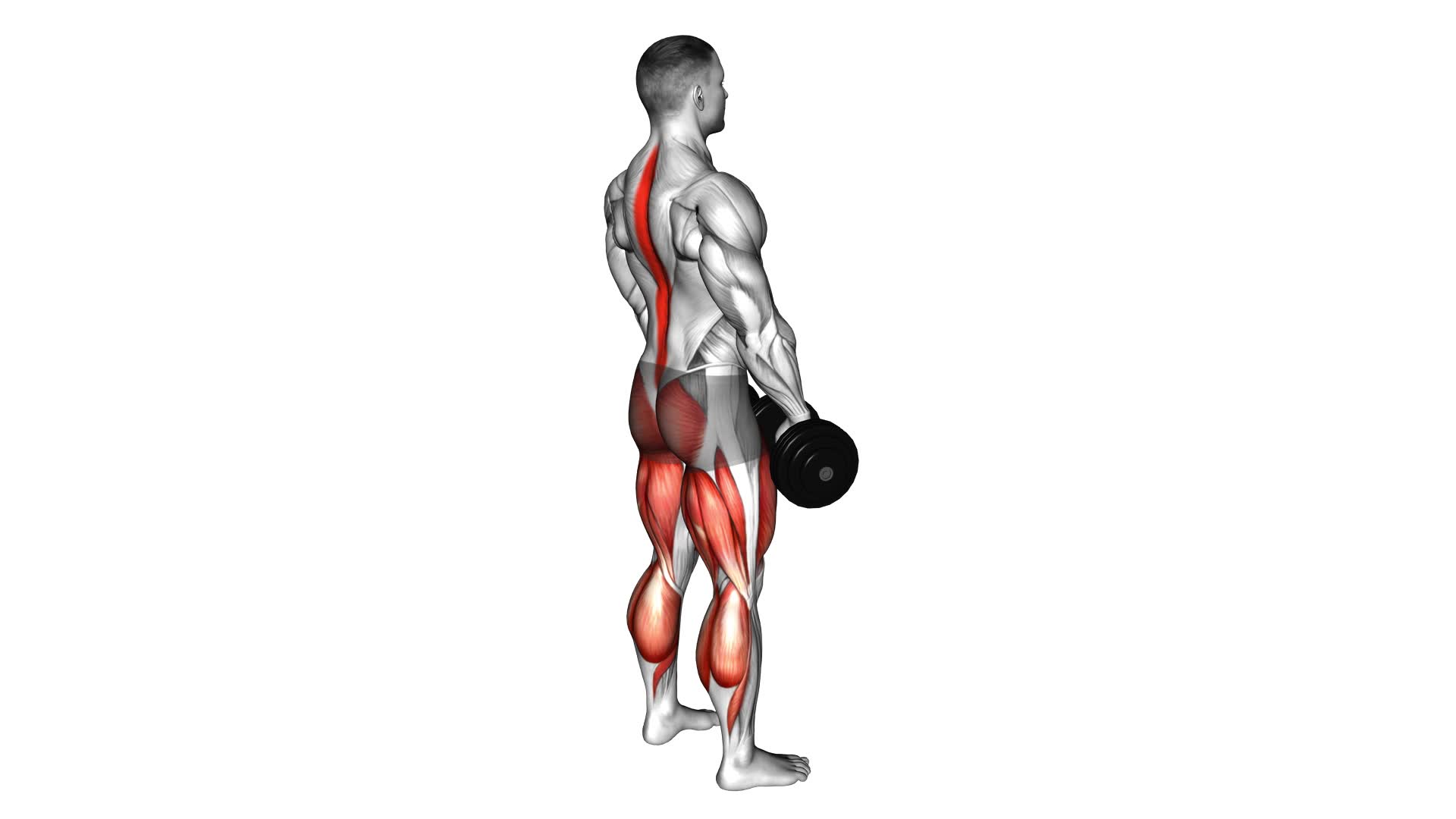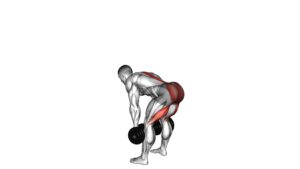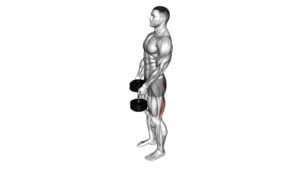Dumbbell Deadlift – Video Exercise Guide & Tips

Are you looking to strengthen your lower body and build muscle? Look no further than the dumbbell deadlift!
Watch This Exercise Video
This exercise targets multiple muscle groups, including your glutes, hamstrings, and lower back.
In this video exercise guide, we'll show you the proper form and technique to maximize your results.
Plus, we'll share variations to challenge yourself and tips for avoiding common mistakes.
Get ready to take your workout to the next level with the dumbbell deadlift!
Key Takeaways
- Targets multiple muscle groups including glutes, hamstrings, and lower back
- Improves overall body stability
- Helps improve posture and reduce the risk of back pain
- Gradually increase weight as strength and technique improve
Benefits of the Dumbbell Deadlift
You can achieve numerous benefits from incorporating the dumbbell deadlift into your workout routine. One of the main advantages of this exercise is the activation of multiple muscle groups. When performing the dumbbell deadlift, you engage muscles such as the glutes, hamstrings, quadriceps, core, and lower back. This comprehensive muscle activation not only helps in building strength but also improves overall body stability.
Another benefit of the dumbbell deadlift is the improvement of functional strength. Functional strength refers to the ability to perform everyday movements with ease and efficiency. By incorporating this exercise into your routine, you can enhance your ability to lift and carry objects in real-life situations. This can be particularly beneficial for those who've physically demanding jobs or participate in sports that require explosive movements.
In addition to muscle activation and functional strength, the dumbbell deadlift also helps in improving posture. As you lift the dumbbells, you engage your core muscles, which play a crucial role in maintaining proper posture. By strengthening your core and improving your posture, you can reduce the risk of developing back pain and other related issues.
Proper Form and Technique
To perform the dumbbell deadlift with proper form and technique, it's important to focus on maintaining a neutral spine and engaging the correct muscles throughout the movement. Start by standing with your feet shoulder-width apart and the dumbbells on the floor in front of you. Bend at the hips and knees, keeping your back straight and your chest lifted. Grab the dumbbells with a firm grip, making sure your palms are facing your body. As you begin to stand up, drive through your heels, keeping your back straight and your core engaged. Lift the dumbbells up to hip level, squeezing your glutes at the top of the movement.
One common mistake to avoid is rounding your back during the exercise. This can put unnecessary strain on your spine and increase the risk of injury. To prevent this, focus on keeping your core tight and your back straight throughout the entire movement. Another mistake is using your arms to lift the dumbbells, rather than relying on your legs and hips. This can limit the effectiveness of the exercise and put unnecessary strain on your shoulders. Remember to use your legs and hips to power the movement, while keeping your arms relaxed.
Here is a sample workout incorporating the dumbbell deadlift:
- Dumbbell Deadlift: 3 sets of 8-10 reps
- Goblet Squat: 3 sets of 10-12 reps
- Romanian Deadlift: 3 sets of 8-10 reps
- Single-Leg Deadlift: 3 sets of 10-12 reps per leg
Remember to start with lighter weights and gradually increase the load as you become more comfortable with the exercise. Focus on maintaining proper form and technique throughout each repetition.
Variations to Challenge Yourself
As you progress in your dumbbell deadlift training, you can explore various variations to further challenge yourself and target different muscle groups. One advanced modification you can try is the deficit dumbbell deadlift. This variation involves standing on an elevated platform, such as weight plates or a step, while performing the exercise. By increasing the range of motion, you'll engage your muscles even more, particularly your hamstrings and glutes.
Another option to consider is the single-leg dumbbell deadlift. Instead of using both legs to lift the dumbbells, you'll balance on one leg while performing the exercise. This variation not only challenges your stability and core strength but also places a greater emphasis on each leg individually.
If you're looking to switch things up, you can also try using alternative equipment options. Instead of dumbbells, you can use kettlebells, barbells, or even resistance bands to perform the deadlift. Each option provides a slightly different feel and can help you target your muscles in unique ways.
By incorporating these advanced modifications and alternative equipment options into your dumbbell deadlift training, you'll continue to challenge yourself and keep your workouts fresh.
Now, let's move on to the next section and discuss common mistakes to avoid when performing the dumbbell deadlift.
Common Mistakes to Avoid
What are some common mistakes to avoid when performing the dumbbell deadlift?
Proper technique is crucial when it comes to executing the dumbbell deadlift correctly and safely. By avoiding these common mistakes, you can maximize the benefits of this exercise while minimizing the risk of injury.
One common mistake is rounding your back during the movement. This can put excessive stress on your spine and increase the risk of injury. To avoid this, focus on maintaining a neutral spine throughout the exercise. Keep your chest up, shoulders back, and engage your core to stabilize your spine.
Another mistake to avoid is using excessive weight that you can't handle. It's important to start with a weight that allows you to maintain proper form and control throughout the movement. Gradually increase the weight as your strength and technique improve.
Improper grip is another common mistake. Make sure to grip the dumbbells firmly, with your hands directly under your shoulders. Avoid gripping the weights too tightly, as this can lead to excessive strain on your forearms and wrists.
Lastly, avoid jerking or using momentum to lift the weights. The dumbbell deadlift should be a controlled and deliberate movement. Focus on using your leg and hip muscles to lift the weights, rather than relying on momentum or swinging your arms.
Tips for Maximizing Results
For maximum results, focus on incorporating proper form and gradually increasing the weight when performing the dumbbell deadlift. Proper form is crucial to ensure that you're targeting the correct muscles and minimizing the risk of injury. Start by standing with your feet shoulder-width apart, holding the dumbbells in front of your thighs. Keep your back straight, engage your core, and hinge at the hips to lower the dumbbells towards the ground, keeping them close to your body. As you lift the dumbbells back up, squeeze your glutes and use your hips to drive the movement.
To maximize gains, it's important to gradually increase the weight you're lifting. As you become more comfortable with the exercise, challenge yourself by adding heavier dumbbells. This progressive overload will stimulate muscle growth and strength development. However, it's important to listen to your body and not push yourself too far, as this can lead to injuries.
In addition to the dumbbell deadlift, incorporating other exercises such as squats, lunges, and hip thrusts into your workout routine can further enhance your gains. These exercises target the same muscle groups and can help to improve your overall strength and stability.
Now that you have an understanding of the proper form and tips for maximizing your results, let's move on to a sample dumbbell deadlift workout to put your knowledge into action.
Sample Dumbbell Deadlift Workout
To begin your sample dumbbell deadlift workout, start by selecting an appropriate weight and warming up your muscles. It's important to choose a weight that challenges you but still allows you to maintain proper form throughout the exercise. As a beginner, it's recommended to start with lighter weights and gradually increase the weight as you become more comfortable and confident with the movement.
Before diving into the workout, it's crucial to properly warm up your muscles to prevent injury. You can start with a few minutes of light cardio such as jogging or jumping jacks to get your blood flowing. Then, perform dynamic stretches that target the muscles involved in the dumbbell deadlift, such as hip circles, leg swings, and torso twists.
Now that you're warmed up and ready to go, let's discuss some dumbbell deadlift alternatives that you can incorporate into your workout. If you find the traditional dumbbell deadlift too challenging at first, you can try performing the exercise with a kettlebell. The kettlebell deadlift is similar to the dumbbell deadlift but can be easier to grip and control.
Another alternative is the single-leg dumbbell deadlift. This variation not only targets your glutes and hamstrings but also improves balance and stability. To perform this exercise, hold a dumbbell in one hand and lift the opposite leg behind you while hinging at the hips and keeping your back straight.
Incorporating these alternatives into your sample dumbbell deadlift workout will add variety and challenge to your routine. Remember to always listen to your body and adjust the weight and intensity as needed.
Frequently Asked Questions
How Much Weight Should I Start With When Performing the Dumbbell Deadlift?
When starting the dumbbell deadlift, it's important to choose a weight that challenges you but also allows for proper form. Begin with a weight that you can comfortably lift for 8-10 repetitions. As you become more comfortable and stronger, gradually increase the weight.
If you have lower back pain, it's important to modify the exercise and consult with a professional. Focus on maintaining a neutral spine and consider using lighter weights or alternative exercises to avoid exacerbating your pain.
Can the Dumbbell Deadlift Be Modified for Individuals With Lower Back Pain?
To modify the dumbbell deadlift for lower back pain, there are a few exercises that can provide relief.
One option is the kettlebell swing, which targets the glutes and hamstrings while minimizing stress on the lower back.
Another exercise to consider is the hip thrust, which strengthens the glutes and core without straining the lower back.
Additionally, incorporating exercises such as the bird dog and cat-cow can help improve stability and flexibility, reducing the risk of further pain or injury.
Is It Necessary to Use a Specific Type of Dumbbell for This Exercise?
When doing the dumbbell deadlift, it's important to know if you need a specific type of dumbbell. The good news is that you can use any type of dumbbell for this exercise. Whether it's a standard dumbbell, a hex dumbbell, or an adjustable dumbbell, they all work just fine.
The benefits of the dumbbell deadlift go beyond just targeting your lower body. It also helps to strengthen your overall body, including your core and back muscles.
Are There Any Alternative Exercises That Target Similar Muscle Groups as the Dumbbell Deadlift?
If you're looking for alternative exercises that target similar muscle groups as the dumbbell deadlift, there are a few options to consider.
One option is the barbell deadlift, which is similar to the dumbbell deadlift but uses a barbell instead.
Another option is the kettlebell swing, which also targets the muscles of the legs, hips, and lower back.
Additionally, the Romanian deadlift or the sumo deadlift can be effective alternatives for targeting these muscle groups.
Can the Dumbbell Deadlift Help Improve Posture and Overall Body Balance?
Improving your posture and overall body balance is a key benefit of the dumbbell deadlift. By engaging the muscles in your back, core, and legs, this exercise helps strengthen and stabilize your body.
It promotes proper alignment and can help correct any imbalances you may have. By incorporating the dumbbell deadlift into your routine, you'll be on your way to a stronger, more balanced physique.
Conclusion
In conclusion, the dumbbell deadlift is an effective exercise that offers numerous benefits for strength training. By maintaining proper form and technique, individuals can target various muscle groups while reducing the risk of injury.
Moreover, incorporating variations and avoiding common mistakes can help challenge oneself and maximize results.
By following the tips provided and incorporating the dumbbell deadlift into a well-rounded workout routine, individuals can achieve their fitness goals and improve overall strength and stability.

Author
Years ago, the spark of my life’s passion ignited in my mind the moment I stepped into the local gym for the first time. The inaugural bead of perspiration, the initial endeavor, the very first surge of endorphins, and a sense of pride that washed over me post-workout marked the beginning of my deep-seated interest in strength sports, fitness, and sports nutrition. This very curiosity blossomed rapidly into a profound fascination, propelling me to earn a Master’s degree in Physical Education from the Academy of Physical Education in Krakow, followed by a Sports Manager diploma from the Jagiellonian University. My journey of growth led me to gain more specialized qualifications, such as being a certified personal trainer with a focus on sports dietetics, a lifeguard, and an instructor for wellness and corrective gymnastics. Theoretical knowledge paired seamlessly with practical experience, reinforcing my belief that the transformation of individuals under my guidance was also a reflection of my personal growth. This belief holds true even today. Each day, I strive to push the boundaries and explore new realms. These realms gently elevate me to greater heights. The unique combination of passion for my field and the continuous quest for growth fuels my drive to break new ground.







